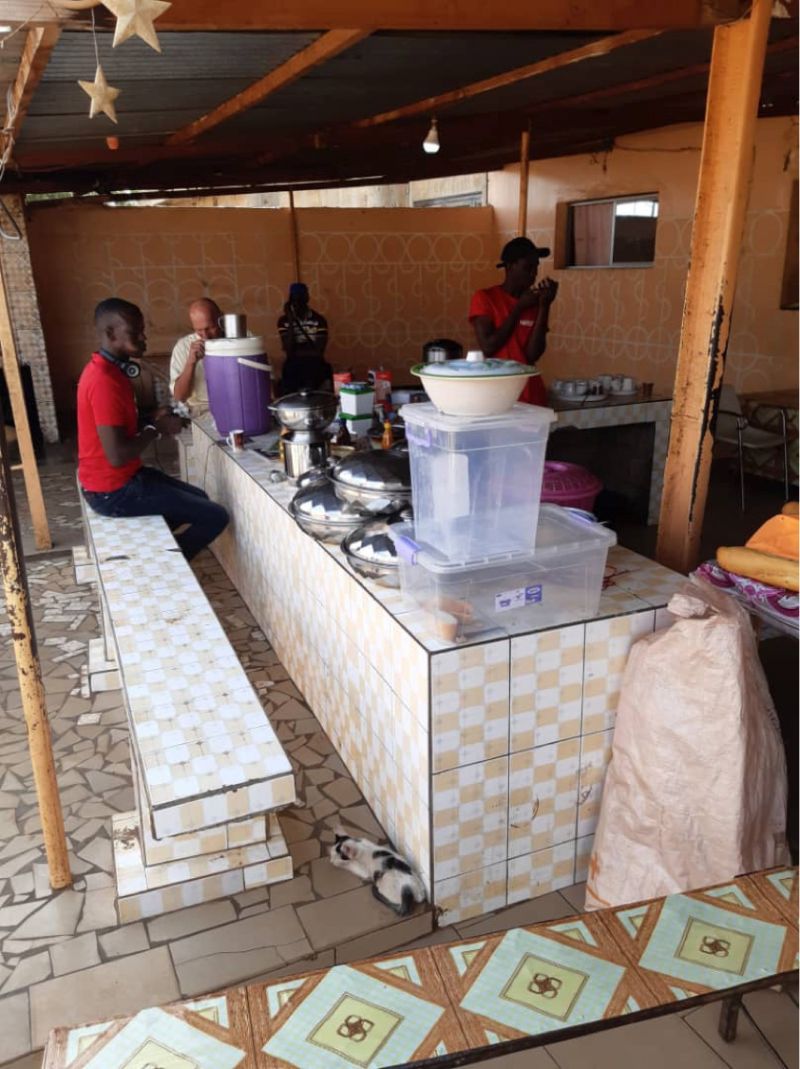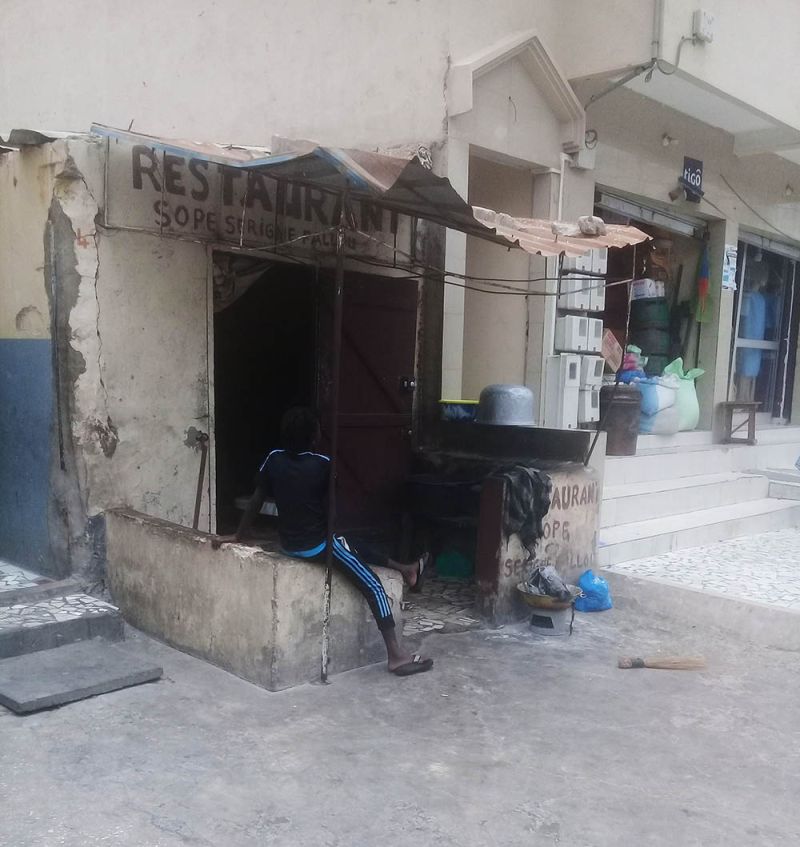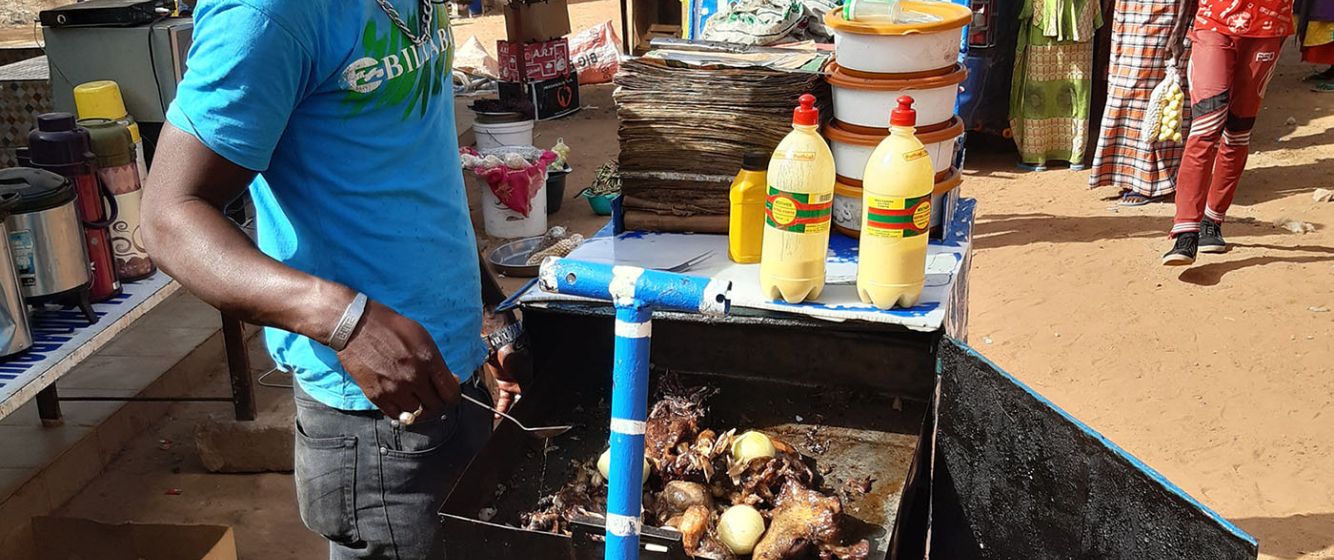From 5-7 July 2019, Jeanne Thérèse Fatou Diouf and Assane Kébé conducted a survey on street food in Dakar (Senegal) as part of the project Atelier Populaire: Building New Knowledge and Practices on Street Food in Saint-Louis, Senegal, led by Gaston Berger University, Saint-Louis, one of the participators in the Humanities across Borders programme at IIAS.1 On 27 October 2019, Bruno Diomaye Faye visited Saint-Louis in a similar capacity. The main objectives of this project include the creation of a resilient urban community and the organisation of an experimental school and street food festival. In this article, the authors reflect on what they encountered during their research and offer a window to the changing cultural world of ‘food’.
By Bruno Diomaye Faye, Jeanne Thérèse Fatou Diouf and Assane Kébé
Delicious food across borders
Bruno to vendor: Are you a Moor? Vendor: I am a Pulaar (an ethnic group from Senegal) sir, and I am from Aere Lao. You can't read? It's nevertheless well written on my beautiful stove! ... I know this way of preparing meat better than the Moors. It is a job, like any other, that does not belong to any ethnic group. (Exchange between forox-caaya salesman and Bruno at Ngoumba Guéoul, a stopover 91 km from Saint-Louis.)
Forox-caaya in Wolof (pronounced forokh thiaya) is the shortened form of forokh thiaya neex dibi, which in Wolof literally means ‘dirty pants but delicious meat’. This popular expression in Senegal comes from a joke about the Thiaya, which are baggy pants typically worn by the Moors. The word forokh here should not however be taken in the first degree (dirty), because it can also designate something with a fermented taste, so delicious. Forokh thiaya is here a way to explain in a joyful yet teasing way the excellent taste of this preparation.

Forox-caaya
Photo by Bruno Diomaye Faye.
In the above exchange that lasted less than five minutes, the pride and ownership of the vendor comes through clearly. What made Bruno ask the vendor if he was a Moor? Why did the vendor respond thus? What does this exchange say about the dialogues and practices around food? Food, practice, cuisine, food preparation, food-related identity and a whole spectrum of aspects related to food can belong to a specific group and yet have the capacity to cross both cultural and geographic borders.
Spaces, flavours, sounds and aromas of street vending
When we started the survey on street food in Dakar and its environs, the impressive number of shops alongside the busiest roads immediately struck us, giving the impression that the whole city had turned into a street food market. There was a buzz of sounds, smells, voices, languages, and colours; a rush of yellow-black taxis honking away, buses and the constant flow of passengers. On every street corner, various food outlets seem to compete for customers with other types of businesses.
These places are either ‘canteens[i]’, or private garages converted into catering spaces, or metal and wooden kiosks on the side of the road or fixed to a wall. The majority of the places offer very basic facilities. Some have simple tables set in the open air; some in full sun, while others, like breakfast sellers, tie sheets together to create a form of shelter. The makeshift nature of the physical structures seems to match the clientele consisting of commuters, workers, shoppers and other visitors.
The food preparation facilities are usually quite rudimentary: stainless steel, plastic and glass containers, spoons, dishes, a gas stove or coal furnace, plastic tubs for cleaning, a few 20-litre oil cans recycled into water reserves and a stack of newspapers used for packaging. In the middle of the day, it is also common to find a salesman immediately next door who, after the meal, offers local sweets and fresh juices or coffee and tea.
These canteens and makeshift eating spaces can be found near all major arteries, markets, bus and taxi terminals, schools, hospitals and large companies. They are sometimes cleared by the municipality, which struggles to cope with the congested sidewalks, yet their physical structures seem to fit in well with the constant flow of people through the city.

Preparation of lunches in large pots placed inside, around or in front of the restaurant.
Photo by Jeanne T. F. Diouf.
On his field trip to Saint-Louis, a three hour bus ride from Dakar, Bruno came across a similar set-up at one of the stops along the way (Ngoumba Guéoul, 91 km from SaintLouis). It was quite a large place, with a shop, a refreshment bar, a fast-food restaurant, toilets and a large courtyard. Several types of food were displayed on the cement and tiled tables standing side by side in front of the restaurant. There were people in red T-shirts who all seemed to belong to the same establishment. There was also a table with eight coffee and tea thermos cans, and a music system broadcasting Islamic songs.
Depending on the location and the type of food, you encounter several types of vendors. At markets, for example, lunch is usually prepared by women who have moved to the capital to devote themselves to the restaurant business.
In residential neighbourhoods, breakfast vendors are generally local residents who set up on a corner near their homes to offer food to neighbours and passers-by. There are also a large number of migrants from sub-regions (Hausa of Niger, Fulani of Guinea, Moors) who tend to sell meat prepared in a unique way. The clientele is just as diverse, ranging from bus and taxi drivers, market and construction workers from nearby sites, to students and families.
We were amazed by the growing trend among Senegalese to eat outdoors. Before the 1990s, for cultural reasons, eating out was formally forbidden, as was to buy and eat food on the street. In fact, it was prohibited to eat anywhere else than in the family home, with the only exception being family events, such as baptisms, weddings and funerals. Eating in public was considered very ‘risky’. Growing up with these taboos, eating on the street is still extremely difficult for the older generation. This is not the case for the generations that followed; young students, for example, developed the habit because they spend the whole day at school, away from home; and some woman nowadays work outdoors, not in their homes, and no longer have the time to cook like they used to. As a result of these developments, street food has become a convenient alternative for modern Senegalese families.
As many customers as there are tastes
Depending on the time of day, a variety of meals and tastes are served to the diverse clientele. For breakfast, for example, saleswomen present bowls on a table containing different sauces so that they can prepare sandwiches tailored to each individual customer. These are consumed either onsite or taken away, wrapped in newspaper. Arame’s table displays bowls containing mayonnaise, tuna, pea sauce, spaghetti, french fries, canned meat, ndambé (local bean stew), etc. He adds seasonings and spices (chilli, pepper, broth) to suit the taste of his customers.

One of the concrete food-stalls, Ngoumba Guéoul.
Photo by Bruno Diomaye Faye.
At lunchtime, most dishes are served with rice. The favourite Senegalese dish, ceebu jën (fish-rice), is cooked everywhere. However, because of the different kinds of people passing through the city and with people willing to try out more dishes, most food stalls offer more than just one dish. Ñaari cinn [lit. two pots] refers to all dishes that are prepared in two separate pots: one for the white rice and the other for the sauce. Arame shared: “There are as many tastes as there are customers. You have to prepare as much as possible to have good sales daily.” Khady, another vendor was of a similar opinion. Apart from fish-rice, she prepares mafé, white rice and peanut sauce, supp-kànja, white rice and okra sauce, and other examples of ‘two pots’, all Senegalese dishes. The dishes on her menu reflect the clientele that she caters to. Around 5 p.m., small tables or kiosks are set up and offer ‘fataya sandwich’, ‘accra sandwich’ and ‘bread-thon’, which are increasingly popular, especially in residential areas. At 7 p.m., millet porridge [laax], millet couscous [ceere, caagiri] and also dishes from sub-regions [latiéké] are served in the main streets. Later in the evening, there are many sellers of chicken, liver or grilled meat sandwiches.
All of us noted the fluidity of the food, vendors, origin, customers, structures, spaces and tastes. All familiar, and takenfor-granted, sights for the people who live here, yet when they were asked to consider them in the context of the survey, the layers and stories of the food and people helped them place street food in broader perspectives.
The food served at these canteens and other spaces is of single-origin or taste, yet not quite. The fataya sandwich is of Lebanese origin. It is a much-loved choice. The sandwich is a delicious little stuffed meat slipper (beef, chicken, fish, seafood) found on West African markets. When eaten on the go, it is quickly wrapped in paper and bagged. Accra niébé, so-called in Senegal, Ghana and Nigeria, are doughnuts of haricot found throughout Africa. Some of these foods have been transformed over the years. The thick millet porridge accompanied by sweet curd, long consumed by peasants, also has a less thick variant, fondé, which is eaten in urban areas for dinner or as a dessert. Laax and Caagiri are very popular for particular occasions, such as baptisms or the end of Ramadan. Forokh Thiaya is a meat soup usually prepared and sold by Moors. The vendors walk around with an oven mounted on wheels or with an aluminium container carried on their head, to keep the meal warm, and paper to pack the meals to go. Rice is undoubtedly the staple food for lunch. For dinner, bread still occupies a central place along with products made from cereals (couscous, porridge, etc.).
Food preparation: ideas and judgements
Breakfast is often prepared at home and, if desired, warmed up just before being served to customers. However, in some places breakfast dishes, such as omelettes, french fries, roasted meat and fried potatoes, are cooked in the presence of the customers. This is part of the concept of tangana [it is hot] and refers to the place where the food is cooked, which is often very hot because the same cramped room is used as a kitchen and a dining room at the same time. In some places, lunch is also prepared on the spot in large pots in front of the restaurant.
The way meals are prepared is an important matter. Abdallah, one of the stall owners, told us: “Since I am Muslim, I cannot eat or sell directly what comes from Europe, because I do not know what we did to cut”. He added, “Happiness sought in the afterlife must be reflected in every profession. If the work is not well done, one cannot gain access to salvation. We lose twice: we get tired of looking for money here, and tomorrow, before God, it will be a difficult report”. He believes that, after the difficult conditions of life on earth, Africans cannot run the risk of losing salvation in the afterlife. That is why he does not give in to the ease of using meat that comes from Europe. Meat should be labelled ‘halal’ to at least reassure the consumer. For many like Abdallah, the entire preparation chain is a very serious, even personal matter, especially for reasons related to Islamic (halal) precepts.

Canteen, an extension of the house.
Photo by Jeanne T. F. Diouf.
Amid the colours, smells and stories, we could not help but notice the different standards of hygiene in the preparation of food. When we brought up the issue, some of the sellers said they were in good standing with the State Services in charge of hygiene control, and that they had all their documents in order. They also pointed out that customers are generally very demanding when it comes to hygiene issues. Listening to their answers, we wondered what meaning the Senegalese and others attach to the concept of 'hygiene'. When the three of us sat down to discuss our experiences, it emerged that while a vendor will respond in terms of state services and official papers, the customer will refer to the cleanliness of the place, the utensils, or even the appearance of the vendor.
About the authors:
Bruno Diomaye Faye, project assistant, Phd candidate at Université Gaston Berger de Saint-Louis [email protected]
Jeanne Thérèse Fatou Diouf, project volunteer, student at l'Université Gaston Berger de Saint-Louis [email protected]
Assane Kébé, project volunteer, student at l'Université Gaston Berger de Saint-Louis [email protected]
[i] Premises of variable dimensions built side by side in markets or along busy roads and intended to accommodate businesses.

Comments
I enjoyed reading the…
I enjoyed reading the article very much. It was interesting to note how on one hand food is about group identity but it can also cross borders as reflected in the encounter with Pulaar food vendor. The richness of the street food and practices related with it was revealing.
Ghana-Senegal: An Intersectionality?
This is a very apt and perceptive piece, which reveals an intersectionality between the Ghana and Senegal HaB projects. The evidence is to be found in the statement “Food, practice, cuisine, food preparation, food-related identity and a whole spectrum of aspects related to food can belong to a specific group and yet have the capacity to cross both cultural and geographic borders”. Here we see food across borders, and the imperative to utilize food to construct cross cultural understandings among West Africans, a key objective of Ghana’s Mobilities of Grassroots Pan Africanism. Senegal, through Bruno Diomaye Faye, Jeanne Thérèse Fatou Diouf, and Assane Kébé, offers us an enchanting approach to pan African cuisine, and also makes a powerful case for the feasibility to teach culture through food. A second interesting thing about the article relates to metaphysics. The authors report one of the informants, Abdallah, one of the stall owners, thus: “Since I am Muslim, I cannot eat or sell directly what comes from Europe, because I do not know what we did to cut”. Happiness sought in the afterlife must be reflected in every profession. If the work is not well done, one cannot gain access to salvation. We lose twice: we get tired of looking for money here, and tomorrow, before God, it will be a difficult report”. It is a tremendous thought that eternity depends on time, and what one does by way of selling food on earth! Equally interesting is the attempt by Abdallah to counteract the trend towards globality by refusing to “eat or sell directly what comes from Europe”. Happiness in the afterlife must be a potent drive. Finally, the authors draw our attention to the fact that due to informal nature of the street food enterprise, the activities of the practitioners are not regulated. I have seen this throughout my Africa travels in Accra, Lagos, Nairobi, Dar es Salaam, Bujumbura, Lome, Cotonou etc. I see unwholesome practices. Perhaps, it is true to say “dirty pants but delicious meat” (forokh thiaya neex dibi). Hurray to the authors for such illumination.